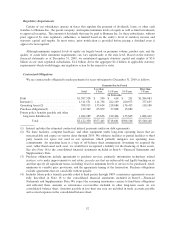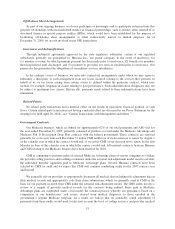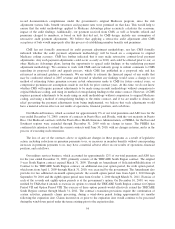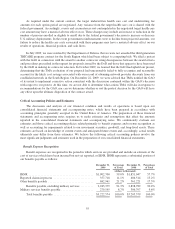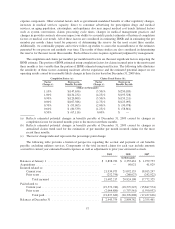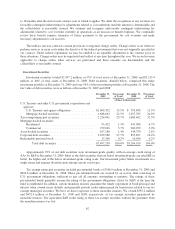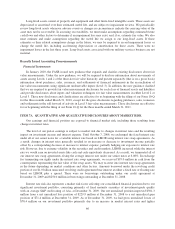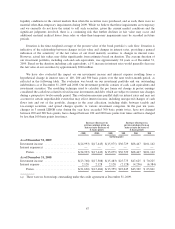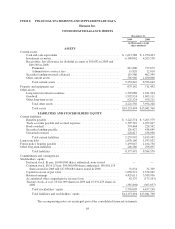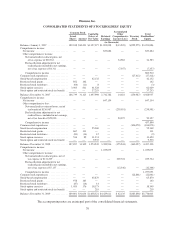Humana 2009 Annual Report Download - page 72
Download and view the complete annual report
Please find page 72 of the 2009 Humana annual report below. You can navigate through the pages in the report by either clicking on the pages listed below, or by using the keyword search tool below to find specific information within the annual report.
to 18 months after the end of each contract year to which it applies. We defer the recognition of any revenues for
favorable contingent underwriting fee adjustments related to cost underruns until the amount is determinable and
the collectibility is reasonably assured. We estimate and recognize unfavorable contingent underwriting fee
adjustments related to cost overruns currently in operations as an increase in benefit expenses. We continually
review these benefit expense estimates of future payments to the government for cost overruns and make
necessary adjustments to our reserves.
The military services contracts contain provisions to negotiate change orders. Change orders occur when we
perform services or incur costs under the directive of the federal government that were not originally specified in
our contract. Under federal regulations we may be entitled to an equitable adjustment to the contract price in
these situations. Change orders may be negotiated and settled at any time throughout the year. We record revenue
applicable to change orders when services are performed and these amounts are determinable and the
collectibility is reasonably assured.
Investment Securities
Investment securities totaled $7,497.2 million, or 53% of total assets at December 31, 2009, and $5,215.4
million, or 40% of total assets at December 31, 2008. Debt securities, detailed below, comprised this entire
investment portfolio at December 31, 2009 and over 99% of this investment portfolio at December 31, 2008. The
fair value of debt securities were as follows at December 31, 2009 and 2008:
December 31,
2009
Percentage
of Total
December 31,
2008
Percentage
of Total
(dollars in thousands)
U.S. Treasury and other U.S. government corporations and
agencies:
U.S. Treasury and agency obligations ............... $1,009,352 13.5% $ 599,898 11.5%
Mortgage-backed securities ....................... 1,688,663 22.5% 1,297,705 24.9%
Tax-exempt municipal securities ....................... 2,224,041 29.7% 1,689,462 32.5%
Mortgage-backed securities:
Residential .................................... 95,412 1.3% 347,308 6.7%
Commercial ................................... 279,626 3.7% 260,299 5.0%
Asset-backed securities .............................. 107,188 1.4% 144,370 2.8%
Corporate debt securities ............................. 2,079,568 27.7% 855,827 16.4%
Redeemable preferred stock .......................... 13,300 0.2% 10,050 0.2%
Total debt securities ......................... $7,497,150 100.0% $5,204,919 100.0%
Approximately 99% of our debt securities were investment-grade quality, with an average credit rating of
AA+ by S&P at December 31, 2009. Most of the debt securities that are below investment-grade are rated BB or
better, the higher end of the below investment-grade rating scale. Our investment policy limits investments in a
single issuer and requires diversification among various asset types.
Tax exempt municipal securities included pre-refunded bonds of $346.9 million at December 31, 2009 and
$694.8 million at December 31, 2008. These pre-refunded bonds are secured by an escrow fund consisting of
U.S. government obligations sufficient to pay off all amounts outstanding at maturity. The ratings of these
pre-refunded bonds generally assume the rating of the government obligations (AAA by S&P) at the time the
fund is established. In addition, certain monoline insurers guarantee the timely repayment of bond principal and
interest when a bond issuer defaults and generally provide credit enhancement for bond issues related to our tax
exempt municipal securities. We have no direct exposure to these monoline insurers. We owned $587.2 million
and $452.4 million at December 31, 2009 and 2008, respectively, of tax exempt securities guaranteed by
monoline insurers. The equivalent S&P credit rating of these tax-exempt securities without the guarantee from
the monoline insurer was AA-.
62


